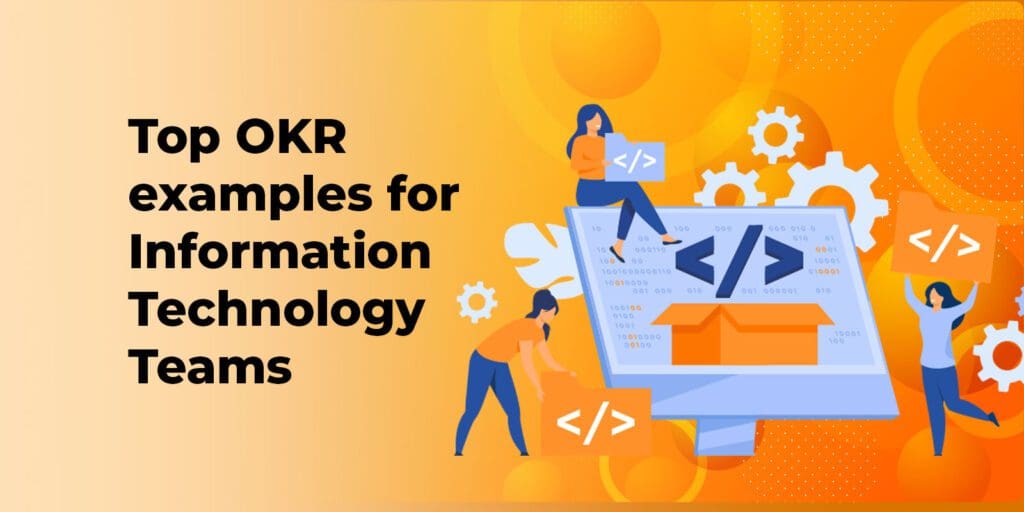Table of Contents
What is OKR?
Objectives and Key Results (OKRs) is an action-oriented execution framework that bridges employee engagement with overall company objectives. With this powerful model, companies can express their goals and ensure it is achieved through appropriate resource allocation.
Through OKRs, good ideas can be executed with proper planning, which also applies to the Information Technology team members. In this blog, let’s look at how OKRs can be used to set and execute goals effectively by the IT team of any organisation.
What is the Importance of an Information Technology Team?
Businesses rely largely on technology to run in today’s digital age. IT teams are crucial to the efficient operation of any organisation for anything from simple duties like email and file sharing to complicated ones like data analytics and cloud computing.
OKRs were initially introduced in the IT industry in the 1990s by companies like Google and Intel, who owe OKRs a huge share of their success stories.
The software development team is tasked with writing codes and handling the technical aspects of a project. They also create the User Interface (UI) and collaborate with backend developers to maintain the front-end and back-end’s proper integration. Thus, the IT team members handle many different demands from clients and the company. With proper goals and objectives set through the OKR framework, they add value to their company and successfully handle the IT domain.
OKR Examples for Information Technology
Here are 9 examples OKRs (Objectives and Key Results) for IT teams
1. To enhance the quality of product releases
- Objective: Enhance the quality of product releases
- Key Result 1: Decrease bug reports from 25 to 15 within 4 months
- Key Result 2: Increase the number of team members in the product testing department from 4 to 10
- Key Result 3: Reduce the average Q/A code evaluation time by 30%
2. To Improve the recovery process for accidental data disasters
- Objective: Improve the recovery process for accidental data disasters
- Key Result 1: Increase the number of local disaster recovery sites from 7 to 20.
- Key Result 2: Regulate data updation from once a month to once every week
- Key Result 3: Increase the number of data centres in the Asian region from 10 to 30
3. To enhance data security measures
- Objective: Enhance data security measures
- Key Result 1: Attain compliance with ISO 27001 certification by the end of the quarter
- Key Result 2: Install 2 antivirus software per computer.
- Key Result 3: Reduce the number of security breaches per month by 40%
4. To Update legacy software systems
- Objective: Update legacy software systems
- Key Result 1: Substitute 3 legacy systems with modern solutions
- Key Result 2: Reduce system maintenance requirement by 20% and employ 2 more staff for this task.
- Key Result 3: Improve overall system performance by 20%


5. To Align communication between the HR team and the IT team
- Objective: Align communication between the HR team and the IT team
- Key Result 1: Improve customer satisfaction by producing an easier User Interface
- Key Result 2: Align HR vision for better IT work culture by improving quality of work life
- Key Result 3: Improve IT team members’ satisfaction and feedback rates by 20%
6. To increase the data analytics capabilities of the IT team
- Objective: Increase the data analytics capabilities of the IT team
- Key Result 1: Hire 2 data scientists to guide and lead the team
- Key Result 2: Achieve improved employee satisfaction rates through better training and engagement by 10%
- Key Result 3: Implement a big data analytics solution
7. To Improve software development effectiveness
- Objective: Improve software development effectiveness
- Key Result 1: Decrease the average time taken to release new features by 2 weeks.
- Key Result 2: Increase code coverage by 20% and involve more automated tests in the process
- Key Result 3: Improve code quality by reducing the number of bugs per deployment from 10 to 5
8. To Use OKR framework to improve customer satisfaction rates
- Objective: Use engineering OKR framework to improve customer satisfaction rates
- Key Result 1: Respond to all customer reviews about the products within 2 days
- Key Result 2: Receive at least 100 5-star ratings on the Play Store.
- Key Result 3: Achieve improved customer satisfaction rates by increasing overall product quality
9. To Streamline data processing
- Objective: Streamline data processing
- Key Result 1: Reduce common data errors by 15%
- Key Result 2: Install 3 new data entry automation software and reduce the time required to process data
- Key result 3: Increase overall data accuracy by 15%
Thus, with the help of the efficient goal-setting framework of OKRs, the Information Technology team of a company can try to continuously improve its efficiency and stay updated on changes in the domain.
IT teams also recognise the priorities of the organisation and align their efforts and focus with that for company success. Since OKRs help teams set and track their objectives and progress transparently, the team understands what is required for better motivation and engagement with the company culture.
Finally, in the face of changing and continually evolving world of technology, the IT industry needs to keep up and face modern challenges like cybersecurity threats, cloud computing, automation, and so on.
Sign up for free and set successful Information Technology OKRs using 10xOKR.com today!
FAQs
What are some common OKR examples for IT teams?
Common OKR examples for IT teams may include objectives such as improving system uptime and reliability, enhancing cybersecurity measures, optimizing IT infrastructure, reducing software bugs and defects, increasing user satisfaction with IT services, and driving digital transformation initiatives.
How should IT OKRs be structured?
IT OKRs should follow the SMART framework, being specific, measurable, attainable, relevant, and time-bound. They should clearly state the desired outcome, have key results that are measurable and tied to the objective, and have a defined timeline for achievement.
How can IT teams benefit from using OKRs?
They provide clarity and focus, align team efforts, and improve communication and collaboration. OKRs also encourage innovation, foster accountability, and enable IT teams to track and measure their progress effectively.



